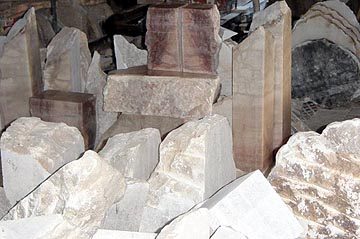Stone Selection
TO SELECTING
YOUR SCULPTURE STONE

HARDNESS – Select a stone with a hardness you are comfortable with. The hardness will affect not only the time it takes to rough out the work but also the finishing, texturing and polishing. Generally from softest to hardest, the sculptor selects from Soapstone, Alabaster, Calcite, Limestone, Marble and Granite. As you grow in experience you will want to try harder stones.
PLACEMENT – Is the stone to be placed outside or is it to remain inside, sheltered from the elements. Generally Soapstones, Alabasters and Calcites should be sheltered form the elements. Virginia Soapstone and limestone do very well outside. This relates closely to the hardness of the stone because the harder the stone the better it will perform outside.
SIZE – Consider the size of the stone. You want a stone that you, or you and your helper can move. Be careful in selecting a small stone, you could end up chasing it around your workbench as it may not provide enough mass and resistance to chisel blows. I recommend 40 to 60 lbs for beginners. For stability, small sculptures should be worked on while attached to a larger mother stone then cut off and finished up. Are you looking for a boulder (basic round), a slab (as in sliced boulders), a long narrow stone (for a tall work) or a square or rectangle? Size of course affects shipping costs. We can ship single stones up to 150lbs by UPS. Larger stones or shipments of many stones will be palletized and shipped by roadway freight lines.
VISION – Consider your vision for your work. Are you looking to create a tall work or a squat, chunky work? If you are in our stone room and selecting your stone it should help to stimulate the shape of the work.
VEINS – If the stone has veins or sedimentary layering, will its direction visually support the lines of the work. If your work is tall and slender do you want the veins to run in the long direction of the work or to cut across the work? At times veins may indicate weak planes of the stone, which should be tested, buy test chiseling to see if it looks like it might split.
COLOR – Is the stone of the color that reinforces your vision for the stone. Wet the stone with a water spray bottle or a hose to bring out its color. If there is a cut flat side on the stone this is a good area to wet.
COMPACTNESS – Is the stone “tight”? Does it have mud in it or fissures? The stone selected for sculpture rarely include these imperfections, but it can happen. You can tap certain stones with a chisel and it will ring. This can’t be done with softer stones like soapstone. One of the best stones to listen to for a ring is Italian white alabaster. Marble will also ring. You will develop a sound recognition as you go around tapping the stones. This is not 100% trustworthy, but it helps.
A parting thought. Each stone holds its own secrets. Often our sculptural vision changes to accommodate the stone. Did you know that Michelangelo’s DAVID was carved from a stone that was discarded by another sculptor due to an imperfection. He simply worked around (carved out) the imperfections.